- The US needs better maize.
- German genebank looks for the best potatoes.
- Vietnam looks for better rice in IRRI’s genebank.
- New Zealand markets an endophyte for better grass performance.
- Some Timor-Leste fish are better than others.
- The Himalayas have a better pea. Of some kind.
- How’s that for subversive cataloguing?
Brainfood: Genebank metrics, Genebank reviews, Botanic gardens ABS, Genebank practical guides, Germplasm User Groups
- A Proposal for Genebank Metrics to Enhance Collection Management. A framework of 10 mandatory and 38 optional metrics for orthodox-seed genebank collections (covering size, documentation, conservation, availability, distribution etc.) to improve performance, transparency and collaboration in genebank management.
- Genebank Peer Reviews: A powerful tool to improve genebank quality and promote collaboration. Starting in 2019, a peer-review system among European genebanks involving self-assessments, site visits and expert evaluation has helped improve practices, strengthen capacity, and foster knowledge exchange, though it requires sustained resources and a pool of experts. I suspect they’re using at least some of the above metrics.
- Could botanic gardens use the Plant Treaty to regulate plant material more effectively? Yes they could, just like genebanks already do. And yes, I am sure there are metrics.
- Release of two new practical guides to support ex-situ conservation in genebanks. FAO publishes new guides to help genebanks implement the Genebank Standards in practice for non-orthodox seeds and cryopreservation, aiming to reduce technical barriers and improve consistency. Now for some metrics.
- Unlocking genebanks for farmer resilience: Assessing the impact of ‘Germplasm User Groups’ in enhancing farmers’ access to diversity. In five African countries, forming “Germplasm User Groups” connecting farmers to national genebanks increases awareness, improves access to crop diversity, generates seed sharing spillovers, and hopefully helps farmers respond to climate-related challenges.
Want to know what AI makes of the above? “Genebanks are sharpening their tools: new metrics set benchmarks for performance, peer reviews foster collaboration, and the Plant Treaty offers clearer rules for sharing, FAO’s practical guides make standards easier to apply, while Germplasm User Groups show how farmers benefit when genebanks open their doors.” Sounds good to me. But to what extent will also this be adopted around the world, and will it last?
A breed is a breed is a breed?
I feel maybe yesterday’s Nibble on the definition of a “breed” may have been a bit too laconic, even for me. So let me give a bit more context.

The link was to a YouTube playlist, which was described thus (link added):
The presentations in this playlist are from the webinar on “Genomic assessment of genetic variation and the future of the breed concept”, originally held on 12.12.2024 under the umbrella of the Food and Agricultural Organization (FAO). This represents the culmination of collaborative work by a diverse group of experts from institutions from all around the world to prepare materials for a sub-chapter in the upcoming 3rd Report on the State of the World’s Animal Genetic Resources for Food and Agriculture.
It amounts to over an hour of talks, but if I had to summarize the point the playlist is making, it is that genomics is redefining a breed as a fluid, porous, genotypically-characterized population rather than a fixed, pedigree-based, phenotypic entity. Thus, it is shifting livestock conservation from saving labels (“Breed A”) to preserving genetic options.
Here’s a handy table I came up with to describe the change:
Interesting to juxtapose this to the post a few days ago on how to value and use Indigenous knowledge to solve today’s problems. Would Indigenous livestock keepers necessarily care about those genetic options more than their traditional breed?
It would be great to hear from people engaged in livestock conservation on this. It’s unfortunately not a community I interact with much.
Nibbles: Supermarkets, Cate Blanchett, ABS, Transformation, Medieval haymaking, Aurochs rewilding, Breed concept
- What’s wrong with supermarkets.
- Cate Blanchett on the Millennium Seed Bank. Attitude to supermarkets unknown.
- Access & Benefit Sharing 101. Cate Blanchett unavailable for comment.
- Experts weigh in on how we should change how we eat. Nobody but Cate Blanchett will listen, but supermarkets and seeds feature, for what it’s worth.
- How they ate in the Middle Ages without supermarkets. Or at least harvested.
- After we’re done with medieval haymaking, let’s bring back the aurochs too. And put it in a supermarket?
- Yeah but what is a breed anyway? Or an aurochs, for that matter.
Brainfood: Core collections of…durum, deulkkae, barnyard millet, durian, sesame, flax, Fendler’s horsenettle, jute mallow, barley
- Creation of a core set of durum wheat accessions based on agro-morphological traits with maximum diversity and lower redundancy. From 710 to 13 accessions (2%!) using 32 morphological traits, thanks to Power Core.
- Construction of a core collection of Perilla frutescens (L.) Britton Germplasm in the South Korean gene bank using agro-morphological traits. From 1227 to 235 accessions (19%) using 17 morphological traits, thanks to a bunch of different methods.
- Comprehensive Phenotyping of 1,807 Indian Barnyard Millet (Echinochloa frumentacea Link) Accessions from Indian National Genebank: Unlocking Diversity for Core Set Development. From 1,807 to 271 accessions (15%) using 23 quantitative traits, thanks to Core Hunter 3.
- Genomic resequencing reveals genetic diversity, population structure, and core collection of durian germplasm. From 114 to 26 accessions (23%) using 39 million high-quality SNPs across the genome.
- Development of a composite core collection from 5,856 sesame accessions being conserved in the Indian National Genebank. From 5,856 to 1,768 accessions (30%) using SNPs and phenotypic data.
- Optimizing core collections for genetic studies: a worldwide flax germplasm case study. From 1,593 to 350 accessions (22%) using phenotypic and genotypic data, times 200, thanks to CoreCollection, corehunter III, TrainSel, and more.
- An Optimized Core Sample of the Wild Potato Solanum fendleri in the USA. From 269 accessions, to 38 plants, to 1 accession (0.4%!). Beat that!
- Countrywide Corchorus olitorius L. core collection shows an adaptive potential for future climate in Benin. From 305 to 54 accessions (18%) using 1,114 high-quality SNPs, thanks to ShinyCore. Some indication of usefulness.
- Multi-environmental evaluation of barley core collection against spot blotch for genetic variability and identification of promising genotypes exhibiting resistance. From a core collection of 678 accessions to 2 genotypes that might actually be useful to breeders. Finally!
